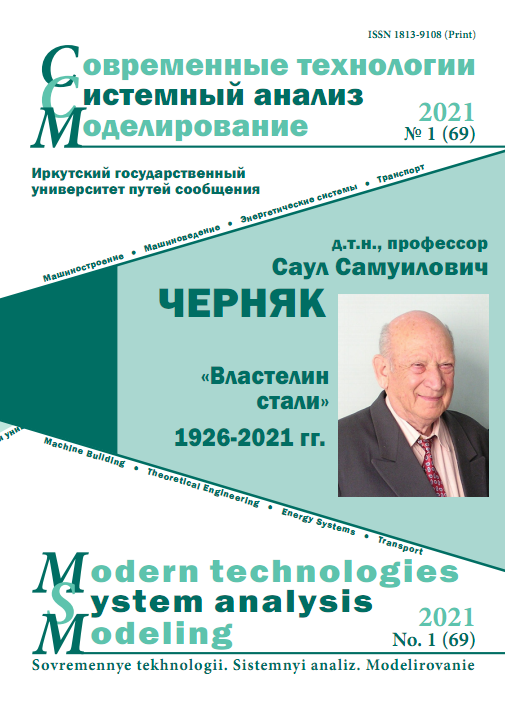Компьютерное моделирование раскачивания груза при телескопировании
Ключевые слова:
телескопическая стрела, динамическая модель, управление движением, раскачивание груза, «Универсальный механизм»Аннотация
В статье представлена компьютерная динамическая модель раскачивания груза на канате при различных управлениях выдвижением секций телескопической стрелы крана. Цель работы – анализ возможности снижения раскачивания груза на канате при различных управлениях выдвижением секций телескопической стрелы крана. Методом проведения работы является компьютерное моделирование движения телескопической стрелы с грузом с учетом механических характеристик канатов, секций и их контактного взаимодействия с использованием программного комплекса «Универсальный механизм». Проведено моделирование движения телескопической стрелы с грузом с одноэтапным и трехэтапными режимами управления, с зависимостью скорости выдвижения от времени и перемещения. Моделирование показало, что трехэтапный режим управления движением с переменным ускорением лучше снижает колебания груза по сравнению с двумя другими рассмотренными режимами, хотя максимальные значения отклонения и угла перекоса груза в большей мере зависят от ускорения движения секций, чем от закона движения. Использование зависимости скорости выдвижения от перемещения менее эффективно, чем зависимости от времени, и замедляет движение секций. Погрешность позиционирования обусловлена отличием фактической скорости выдвижения секций от заданной и составляет 0,8–1,3 %. Погрешность позиционирования может быть уменьшена уточнением значений силы гидроцилиндра. Компьютерную модель и установленные закономерности телескопирования грузов целесообразно использовать при проектировании монтажных операций, осуществляемых грузоподъемными кранами с телескопическими стрелами.
Библиографические ссылки
An anti-swing and positioning controller for overhead cranes based on multi-sliding mode method / W. Xu, B. Liu, J.Chu et al. // Advanced Materials Research Vol. 468–471. Р. 328–334. DOI: 10.4028/www.scientific.net/AMR.468-471.328.
Sorensen K., Singhose W., Dickerson S.A controller enabling precise positioning and sway reduction in bridge and gantry cranes // Control Eng. Pract. 2007. Vol. 15. P. 825–837. DOI:10.1016/j.conengprac.2006.03.005.
Корытов М.С., Щербаков В.С., Титенко В.В. Аналитическое решение задачи разгона груза мостовым краном с постоянным ускорением при гашении колебаний грузового каната // Динамика систем, механизмов и машин. 2017. Т. 5, № 4. С. 132–135. DOI: 10.25206/2310-9793-2017-5-4-132-136.
Singhose W., Kim D., Kenison M. Input shaping control of double-pendulum bridge crane oscillations // Journal of Dynamic Systems, Measurement, and Control Control. 2008. Vol. 130. DOI:10.1115/1.2907363.
Vaughan J., Kim D., Singhose W. Control of tower cranes with double-pendulum payload dynamics // IEEE Trans. Control Syst. Technol. 2010. Vol. 18. P. 1345–1358. DOI:10.1109/TCST.2010.2040178.
Saeidi H., Naraghi M., Raie A. A neural network selftuner based on input shapers behavior for antisway system of gantry cranes // Journal of Vibration and Control. 2013. Vol. 19. P. 1936–1949. DOI: 10.1177/1077546312453065.
Программа ввода данных. Руководство пользователя. URL: http://www.universalmechanism.com/download/80/rus/03_um_data_input_program.pdf (дата обращения 21.12.2020).
Шестеров Ю.В. Моделирование выдвижения секций телескопической стрелы крана // Инновационное развитие подъемно-транспортной техники : материалы Всерос. науч.-практ. конф. Брянск : Изд-во Брян. гос. техн. ун-та, 2019. С. 55–60.
Кран автомобильный КС-55713-5К-1. Руководство по эксплуатации КС-55713-5К-1.00.000 РЭ. URL: http://oaokaz.ru/catalog/avtokran/KS-55713-5K-1 (дата обращения 21.08.2020).
Реутов А.А. Динамическая модель полиспаста механизма подъема груза // Современные инструментальные системы, информационные технологии и инновации : сб. науч. тр. XII Междунар. науч.-практ. конф. Курск : Юго-Запад. гос. ун-т, 2015. Т. 3. С. 391–394.
Tuan L.A., Soon-Geul L., Moon S.C. Partial feedback linearization and sliding mode techniques for 2D crane control // Transactions of the Institute of Measurement and Control covers applications in instrumentation and control. 2014. Vol. 36. P. 78–87. DOI: 10.1177/0142331213492369.
Pai M.C. Closed-loop input shaping control of vibration in flexible structures via adaptive sliding mode control // Shock and Vibration. 2012. Vol. 19. P. 221–233. DOI: 10.1155/2012/803479
An optimal performance control scheme for a 3D gantry crane / M.J. Maghsoudi, Z. Mohamed, A.R. Husain et al. // Me-chanical Systems and Signal Processing. 2016. Vol. 66–67. P. 756–768. DOI: 10.1016/j.ymssp.2015.05.020.
, Yang T., Singhose W. Combined input shaping and feedback control for double-pendulum systems / R. Mar, A. Goy-al, V. Nguyen et al. // Mechanical Systems and Signal Processing. 2017. Vol. 85. P. 267–277. DOI: 10.1016/j.ymssp.2016.08.012.
Duc V., Trong K. Combination of input shaping and radial spring-damper to reduce tridirectional vibration of crane payload // Mechanical Systems and Signal Processing. 2019. Vol. 116. P. 310–321. DOI: 10.1016/j.ymssp.2018.06.056.


